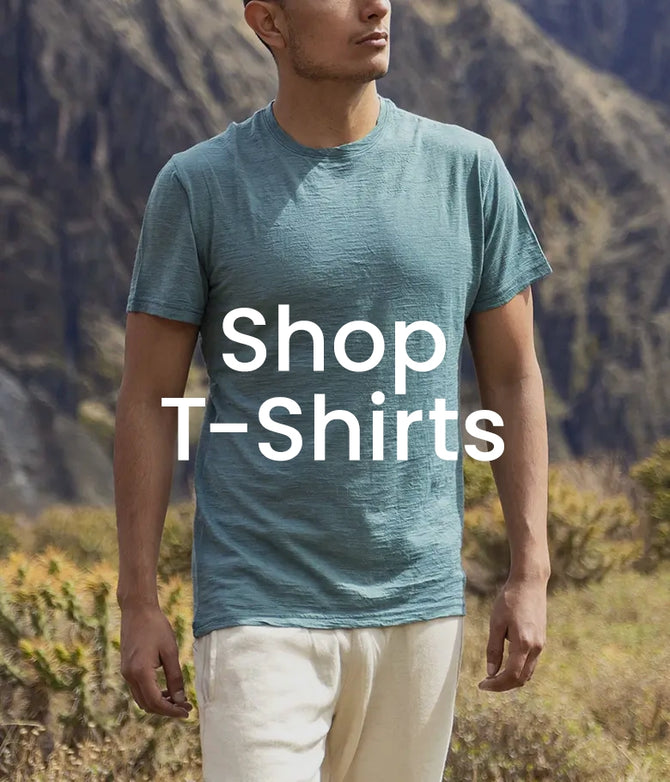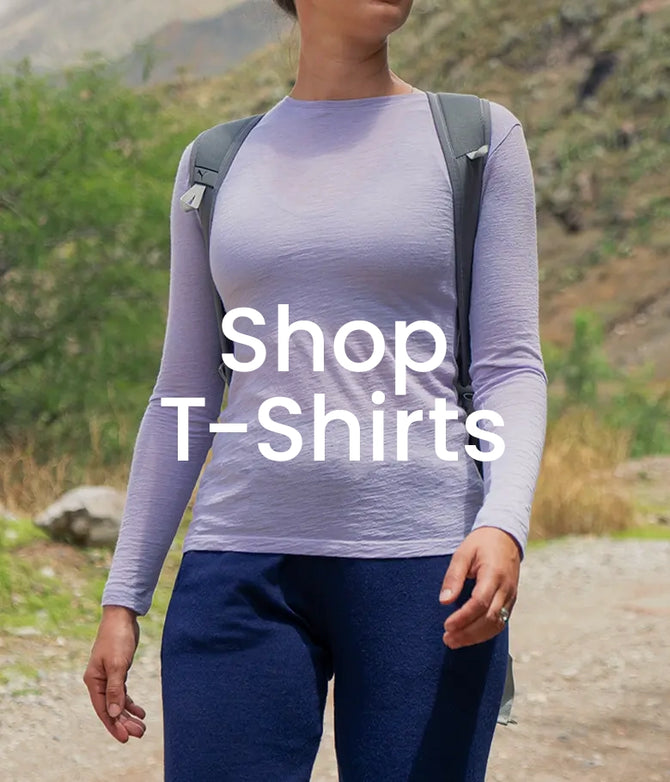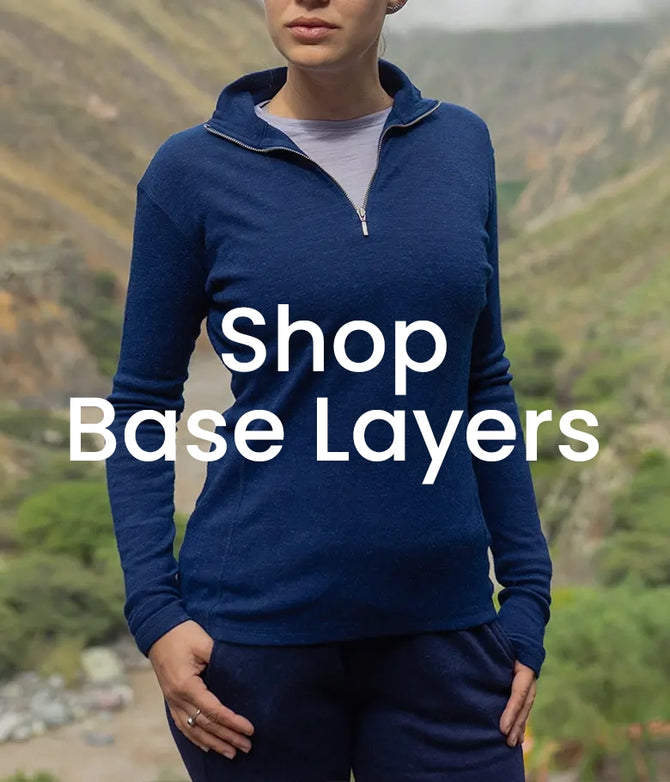Packing for Sustainable Hiking
Published 24th September, 2020
When we head into the hills, most of us don’t just do it for the physical exercise, but also because we love nature. We love the fresh air, the sounds of the countryside, being on a mountainside, in the woods or on a cliff high above the sea. Most of us who spend lots of time outdoors, want to try to protect the natural environments we love, so it is really hard to take when we find out that the gear we use to protect us from the elements and get us through those long days, can actually be detrimental to the environment.
How to Make Your Hiking Pack More Eco-Friendly
Reduce Plastic Use
Plastics are so incredibly versatile, they show up in almost everything we use in the outdoors: footwear to base layers, rucksacks to snacks, and everything in between! The main problems with plastics include: that they come from non-renewable sources (petrochemicals); production involves heavy use of chemicals, water and energy; and plastics last forever in our environment. This is probably one of the most difficult things to get rid of completely from your pack, as there aren't really any viable alternatives for many items, such as the waterproof and breathable fabrics used for outer shells. But there are some things you can do to reduce your plastic use:
- Choose other materials where alternatives exist.
- Choose recycled plastics, instead of virgin plastics.
- Find ways to reuse, upcycle or recycle your plastic-based gear at the end of its useful life.
Recyclability & Biodegradability
We can repurpose and recycle plastics when our gear needs replacing, but eventually most things have an end to their useful lives and end up in landfill. A lot of plastics can be recycled, but it depends where you live, so it’s a good idea to choose gear from companies that will receive used products and take care of their recycling. Natural materials like wool, hemp, wood, bamboo and cotton do biodegrade, but be aware that chemicals used during processing, as well as synthetic dyes, are not biodegradable, and can be detrimental to the environment once the item is discarded.
Reducing Chemical Use
Chemicals are used throughout the outdoor industry at various stages of production: from pesticides for growing fibre-producing plants, to chemicals used in cleaning (e.g. superwashing of wool), or the actual production of the fibre (petrochemicals for plastics and those used to create rayon), to the dyes used to colour your gear. Many of these chemicals are harmful to the environment and can even cause health issues for workers and the end user. Below are some tips for reducing the chemical impact of your outdoor gear:
- Look for companies that are affiliated to programs like Blue Sign, which means they have assessed their use of chemicals and have looked for alternatives to the most toxic and environmentally damaging ones.
- When buying natural fibres, like cotton, hemp and bamboo, choosing “organic” should mean that pesticides, herbicides and other harsh chemicals have not been used.
- For outer shells, try to look for companies that are reducing PFC use in their durable water repellent (DWR) finishes.
Learn about Brand Ethics
Affiliations
With supply chains getting so big, sometimes it’s hard for even the more conscientious companies to stay on top of the production of every single piece of fabric, button and shoelace. But many outdoor brands have statements of ethics or sustainability practices, which include cruelty-free and fair-trade ideals. Several outdoor brands are certified by Responsible Down Standards and quite a few have joined the Sustainable Apparel Coalition, 1% for the Planet, or are certified B Corps. These kinds of certifications can indicate how serious a company is about traceability and the welfare of the people and animals involved in their supply chains. That said, not all companies have the means to join large coalitions or get certified by global organisations, so don’t assume that lack of certification means lack of ethics. Be sure to read the ethics and mission statements, as well as “About Us” pages to get a better idea where each company stands.
Giving Programs
Many companies these days also have giving programs: some donate a percentage of their profits to charity or match purchases with tree-planting, or donations of items (such as shoes or glasses) to those in need. Remember that while philanthropic programs are great ways for companies to “give back”, they need to be well thought out, so as not to do more harm than good, and shouldn’t be used to make up for poor manufacturing practices.

What Truly Eco-Friendly Gear is Out There?
These days, everyone claims sustainability, especially in the outdoor industry. We have looked through a lot of the different brands out there, and have come up with a list of companies that we think are doing a good job, or at least taking steps in the right direction, with regards to your day hiking gear.
*** This is not a definitive list & doesn’t include any affiliate links. Please note that this article is not a direct endorsement of these companies, but it is the author’s opinion based on available information.***
Find out about different elements of your sustainable hiking pack by clicking on the tabs below:
This one is easy: use ALPACA WOOL! Aside from being a high performing technical fibre, Peruvian alpaca wool is sustainably produced, with the animals raised in small herds, by small-scale farmers, in their natural habitat: the Peruvian Andes. Alpaca wool production doesn’t damage the environment and the fibres biodegrade when finally discarded. Arms of Andes single-sources, producing all our clothing in Peru from start to finish, drastically reducing our carbon footprint. For more information about the how sustainable Alpaca Wool is, see our Sustainability page.
Arms of Andes has you covered from head to toe with wool hats, neck warmers, underwear, base layers, mid layers, leggings, jogging bottoms and socks, all made of 100% royal alpaca wool (except the socks which are a blend).

Soft-shell and hard-shell jackets, trousers and technical hiking or climbing pants are a lot tougher. Because of the nature of the activities they are designed for, synthetic fabrics are overwhelmingly prevalent. Unless you are willing to compromise on performance and weight, it’s very hard to find outer shell garments in materials which are truly sustainable and biodegradable. So this is when you want to choose recycled plastics, PFC-free DWR finishes (NikWax has developed a non-toxic, environmentally safe DWR finish, which more brands are now turning to).
Here are some of the companies with good attention to sustainability and ethical issues:

We did find one wind-resistant and water-repellant soft shell on the market that deserves a special mention. The Woolmark Optim WR Jacket is potentially the most sustainable outer shell out there. It is made from 100% merino wool fabric, so is biodegradable and has all the usual benefits of merino wool.
Arms of Andes co-founder, Rensso, picked one up when he was in Australia and loved the fit and performance. The only snag is that you have to be in Australia to get your hands on it (or know someone who can forward it to you) .
Image from the Woolmark website
Rawganique
We found one backpack that can be considered “truly sustainable” made with natural and biodegradable materials.
- The Rawganique handmade vegan organic hemp backpack is produced without chemicals, from organically grown hemp (which is naturally pest resistant and needs much less water than cotton), in “sweatshop free” factories.
- Since the fabric is made from 100% natural fibres and is either left unbleached (the natural option) or dyed with eco-friendly, low-impact dyes (black), this backpack is almost 100% biodegradable (minus the zips of course).
- This pack is quite small (18l) though, with room only for the essentials. Also, it is not a technical hiking pack, so for more complex hikes you might need to look elsewhere.

Copywright Rawganique 2020

Cotopaxi
Another company to consider for your sustainable hiking backpack, especially for something more technical, is Cotopaxi.
- While they use non-biodegradable materials, these are fabric offcuts, so they repurpose materials that would otherwise end up in landfill, without being used.
- Cotopaxi commits to traceability of supply lines as well as fair wages to workers and the company is a certified B-Corp.
- The company also has its own foundation that contributes a portion of profits to varied programs including refugee support, education and malaria prevention.
- The use of offcuts results in unique colourful designs, and packs that are comfortable and more functional for hiking, such as the Luzon Del Día.
Image from the Cotopaxi website
Shoes are another sustainability minefield in the technical clothing world. You often have to compromise comfort and/or performance for true sustainability. Here are a couple of ideas:

Picture from the Allbirds Website
Allbirds
If you’re doing relatively casual day hikes or don’t need a technical shoe, Allbirds is probably the most sustainable active footwear brand on the market.
- They use materials that have low impact on the environment, such as sustainable merino wool, Tencell Lyocell from FSC approved farms and recycled bottles for the shoelaces.
- Their production process has a lower footprint than most shoe production. They aim to become carbon negative, and in the meantime, invest in carbon offsetting schemes.
- With a commitment to traceability in their supply chain and reduction of environmental impact, they are a certified B Corp.
- Allbirds donates lightly used shoes (they have a 30 day trial period) to Soles4Souls to be given to people who need them.
- Most are trainer-type models, but the Mizzles have a “bio-based", water repellent shield, making them more versatile.
Keen
For a technical range of hiking shoes, boots and sandals, Keen is one of the outdoor footwear brands that appears to have the most extensive commitment to sustainability.
- Keen has worked to identify and reduce harmful chemicals in their supply chain, particularly in leather production. They have reduced PFC use (they claim to be 95% PFC free) by developing a PFC free DWR finish for their shoes.
- Although not a member of the Sustainable Apparel Coalition (SAC), Keen uses the SAC’s Higg Index to evaluate and improve the sustainability and ethics of their production processes.
- The company contributes to youth grant programs to immerse kids in the outdoors and also engages in volunteer activities and advocacy campaigns.
Sunscreen
The healthiest and most eco-friendly way to avoid sunburn when hiking, is to cover up and seek shade. There are many lightweight t-shirts – like our Arms of Andes Alpaca Wool Long-Sleeve t-shirt – that protect you from the sun, without causing you to overheat. The face and hands can often be a problem though, especially for those with fairer skin; and sometimes, it's just too hot for long sleeves and trousers. There are hundreds of sunscreens on the market branded as “eco-friendly”, but there is little consensus about what that means. What’s available also varies greatly based on where you are in the world, so it’s hard to pick out one or two of the best options. Instead, look for sunscreens that:
- Don’t contain the most harmful chemicals like oxybenzone and octinoxate (and a whole host of others!), which are of particular concern for water sports.
- Are labelled as “mineral sunscreens” with “non-nano zinc oxide” as the active ingredient.
- Contain ingredients that are biodegradable & organic, other than the active ingredient.
- Are sold in plastic free packaging, like metal tins, bio-degradable cardboard, or recyclable packaging.
Sunglasses
Sunglasses are tricky as it’s hard to find biodegradable frames. Some brands use wood, but this has a reputation for breaking easily. A more eco-friendly option is to choose sunglasses that use recycled materials.
Waterhaul
- Waterhaul frames are made of recycled fishing nets pulled out of the sea and recycled using mechanical methods.
- Most lenses are made of glass for recyclability (the model designed for outdoor activities has plastic lenses for lightness).
- Waterhaul states that they build their products to last and will repair or replace broken glasses free of charge. As a bonus, they recycle broken frames, aiming for a 100% product recycling rate.
- Their packaging is plastic free and recyclable and the cases are made from sustainably produced cork.

Image from the Waterhaul website
Most snacks for hiking come in plastic wrappers, making them very convenient and clean-up free. But just packing out your rubbish isn’t sufficient to really call yourself an "eco-friendly hiker". You can get snacks that focus on eco-friendly production practices, but plastic packaging is almost inescapable with pre-packaged hiking snacks.
The only real solution: make your own snacks! With a lot of research and shopping around, you can control what goes into your trail food. You can check the production practices of the individual elements and avoid environmentally damaging ingredients. If you purchase your ingredients in bulk or from packaging-free stores, and use reusable containers, or eco-friendly food wraps (like organic cotton treated with beeswax), you will find you can avoid plastic almost entirely.
Find some of our favorite hiking snack recipes here and here.

The outdoor industry is still a long way from being able to claim full sustainability, so it’s still hard to get ready for your day hikes (not to mention multi-day trips, where tents, sleeping pads and bags, and a whole host of other things, make everything more complicated), confident that everything you are wearing or have in your rucksack is fully eco-friendly and sustainably produced. But industry leaders and small brands alike are really taking steps towards improving this, so you can make many small changes that really add up.
READ MORE ON OUR BLOG










